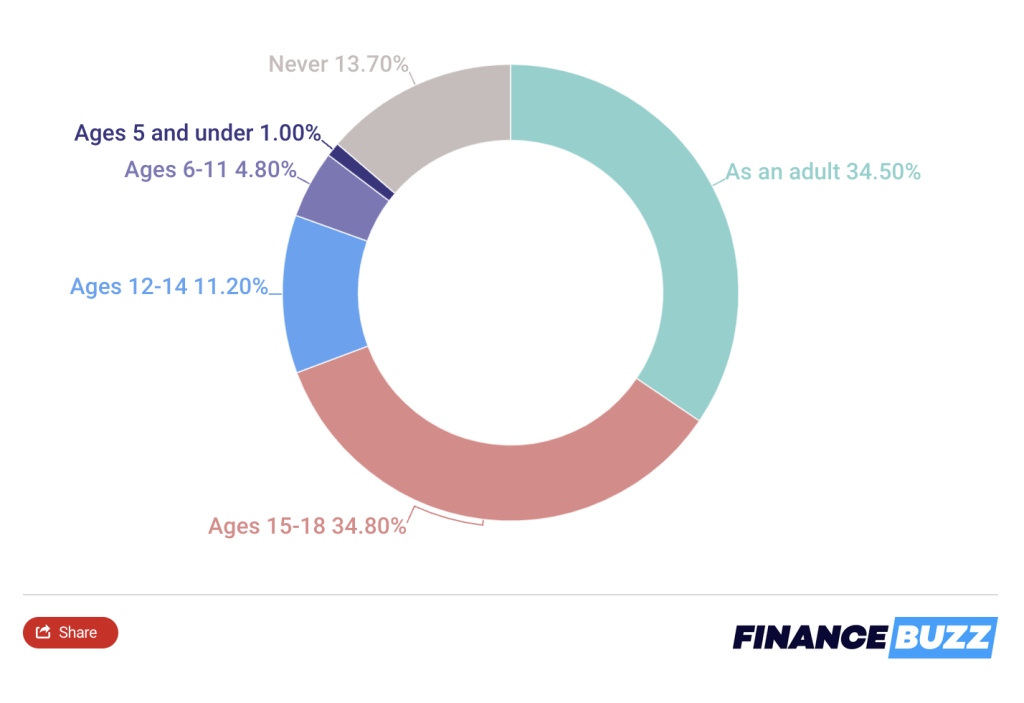Most people find it hard to talk about money, especially between children and their parents. In fact, 57% of parents reported being reluctant to discuss money matters with their children.
Furthermore, another study found that 74% of respondents said parents shouldn’t share information about their kids’ finances with kids under 14 years old, and another 14% said it should never be done.

The good news? Many books are available on the subject of money for parents who lack the expertise, time, or inclination to talk to their children about money. In addition to providing a way to facilitate a discussion about money, reading a book together with your children can also help you address difficult topics. An example would be if a parent lost his or her job, or if the family could not afford to purchase a particular item for the child.
For parents who want to help their children become financially literate, here are the best finance books for kids to learn money.
1. What is Money? Personal Finance for Kids by Kelly Lee
You can never teach kids about money too early. In fact, researchers from Cambridge University recommend that parents teach their kids about money as early as age 3. As such, this book is a great fit for little ones, especially those between the ages of 3 and 6.
By using short stories about money, drawings, simple language, and colorful pages, it explains money and where it comes from, as well as why saving is important. There are even some fun and educational activities at the end.
Seriously. Your kids will love this finance book.
2. The Four Money Bears by Mac Gardner
What does money have to do with bears? A finance book for kids aged 3 to 7 by Mac Gardner, a certified financial planner, features four bears: Saver Bear, Spender Bear, Investor Bear, and Giver Bear.
Working together, they are able to create a budget and learn to manage their money more effectively. Kids can learn about money through the stories and tips of the Four Money Bears and their friends.
As a result of these skills, young children are exposed to healthy financial habits and develop a strong sense of financial literacy. At the end of the finance book, parents can even help kids create their own budget
3. Money Math: Addition and Subtraction by David A. Adler
Kids must first be taught what money is before you can teach them how to value it. With the introduction of US dollar bills and coins, David Adler teaches math basics. In addition to learning who the people on American currency are, kids will also learn their value.
With the finance book, parents are able to keep going back to it as their kids learn how to add and subtract. After they’ve learned to count numbers, they’ll be able to calculate how much change they’ll get back and how long it will take to save up.
4. Investing for Kids: How to Save, Invest and Grow Money by Dylin Redling and Allison Tom
Investing for Kids helps parents raise money-savvy children. Designed for kids aged 8 to 12, it gives them a basic understanding of how money works, including how to earn it and start saving. In turn, this gives kids hope for a bright future filled with money.
Kids aged 8 to 12 will learn how to invest in stocks and bonds, how to choose the right one, and how to build wealth with the help of Dollar Duo, Mr. Finance and Investing Woman. In addition to learning about “risk” and “reward,” kids will also learn how to diversify their portfolio and, ultimately, how to grow their money.
5. A Boy, a Budget, and a Dream (The Wealth ) by Jasmine Paul
Kass is meticulous about budgeting her money. Her brother Joey, however? Well, he’s not as responsible. Eventually, When Joey realizes that he doesn’t have enough money to pay for something he’s been dreaming of, he must either learn to budget or risk giving up on it.
With this finance book, Jasmine Paul, a Certified Financial Education Instructor, teaches kids how to save and be patient. Additionally, it promotes financial literacy, delayed gratification, asking for help, and diversity to children ages 4-8 in a fun and easy-to-understand manner.
6. If you Made a Million by David M. Schwartz
This award-winning finance book explains money and counting principles to 4- to 8-year-old kids through Marvelosissimo the Mathematical Magician. Beginning with a penny and ending with a million dollars, Marvelosissimo shows how coins and paper money add up. As well as talking about banks paying interest on deposits, he also shows how they charge loans to their borrowers.
Those who enjoy this book may also like How Much Is a Million?, which was published in 1989 and reissued in 1994. Other titles by the same team are Millions to Measure.
7. Money Plan by Monica Eaton
In Money Plan, Monica Eaton, a Texas-based certified financial education instructor, tells the story of how a girl named Mia learns about the importance of saving and budgeting. Designed for ages 4 to 7, a younger reader would also understand the concepts-especially if they co-pilot at the supermarket frequently. However, parents may also find it helpful too.
Furthermore, Money Plan helps kids understand needs vs. wants, earning vs. spending, and budgeting. For parents who wish to continue the discussion, each book includes a free teaching guide.
8. Finance 101 for Kids: Money Lessons Children Cannot Afford to Miss by Walter Andal
It has been found that most kids acquire money habits – good or bad – at the age of seven. As such, now is the perfect time to teach your children how to handle money.
It was written by Walter Andal after he became frustrated by the lack of resources that applied financial concepts to real-life scenarios. In order to help children make smart personal financial decisions, he then created an informative and entertaining book. In addition to 101 for Kids, Finance 102 for Kids is available as well.
9. Rock, Brock, and the Savings Shock (Money Tales) by Sheila Bair
Featuring rhyming text by Sheila Bair and illustrated by Barry Gott, Rock, Brock, and the Saving Shock tells the story of twin brothers Rock and Brock, a spender and a saver respectively. In exchange for doing chores, their resourceful grandpa gives the boys a dollar a week. He promises to double their money the following week if they don’t spend it.
Brock ends up with $512, while Rock ends up broke. In the end, Rock learns a valuable lesson and changes his ways. An illustrated table concludes the book, showing Brock’s fortune growing, while Rock’s did not, as well as an overview of compound interest for children.
During the 2007-2008 financial crisis, Bair regularly appeared in the media, calmly assuring Americans that their bank accounts were secure. She served as chairman of the Federal Deposit Insurance Corporation from 2006 to 2011.
10. The Everything Kids’ Money Book: Earn it, save it, and watch it grow! by Brette Sember
Kids can use this book to save for a new bike and invest their allowances online. There will also be lessons for kids about:
- What goes into making coins and bills?
- The things you can buy with money, from school supplies to fun and games.
- An overview of credit cards.
- The best ways to grow your money from savings to stocks.
- Technology that makes finance cool.
The concept of saving money has changed from a piggy bank to a digital wallet. It is common for today’s kids to invest money, start small businesses, and earn interest on their savings. The goal of this book is to teach kids how to save and spend their “green” effectively
11. I Want More Pizza: Real World Money Skills For High School, College, And Beyond by Steve Burkholder
Are you dealing with a teen who is not a big reader? Well, I Want More Pizza is the perfect book for them. I almost think of it as a mini-book since it’s such a quick read. Despite its short length, this finance book still makes a big impact on kids.
To break down barriers that prevent young adults from learning about money management, pizza is used as a model for getting teens interested in something.
The book includes hundreds of real-life examples that teens can choose from, such as goal setting and investing. As a result, they can control the whole process from start to finish. And, eventually, this can help them achieve financial independence.
12. Rethink Money: for Children & Teens by Paul O’Mahony and Chris Farrell
Rethink Money for Children & Teens is a free resource shared by Paul O’Mahony and Chris Farrell on their website Funancial Freedom. Despite the fact that this book is free, it isn’t filled with useless information. In fact, parents will wish they had had this finance book when they were kids since it contains over 300 pages of information they need to know.
The finance book covers wealth-building and helps kids understand the value of starting early. Additionally, the book encourages entrepreneurial mindsets. Today, such strategic thinking is indispensable, whether your child opens a lemonade stand or designs an app that will change the world.
FAQs
How come you start talking about money so early with your kids?
It is not uncommon for children to ask questions about money at a very young age. In fact, as early as age two, children are targeted by advertisers. It is therefore essential that you make sure they have a sense of the potential uses of money beyond just buying things.
What should I do to help my child set their first financial goal?
The time horizon for saving should be short – 4 to 8 weeks for a 4- or 5-year-old. You won’t be able to hold their interest for very long if you wait any longer. An initial goal for a child might be to save $5 a week for 10 weeks for a new toy.
What if I’m uncomfortable teaching my kids about money?
The basics are the best place to start. During this process, you will evolve as well. To begin, focus on the following core concepts:
- Differentiating needs from wants.
- Making smart financial decisions.
- Setting a goal and saving for it.
If necessary, you should change your behavior because your children will watch you closely.
How do I teach my kids to budget?
Kids need to learn how to delay their gratification through budgeting.
To get them started, have them set a time budget. A daily or weekly limit on screen time can be set, for example. When to use that is up to them. However, once it has been used, it is no longer available. If you don’t stick to their budget, they’ll learn that there is no downside to not budging, which can be extremely difficult for you.
They then should then start saving up for something they want. They can budget how much they can spend now versus how much they can save if you give them pocket money, aka an allowance.
Is it a good idea to open a savings account for my children?
Definitely! Investing is better, however.
Having a savings account will enable them to see how their savings grow over time.
Set up an investment account for your young children (under 12). Even if the stock market falls in the short term, these funds have plenty of time to grow before they become adults.
The post The 12 Best Finance Books for Kids to Learn Money appeared first on Due.
